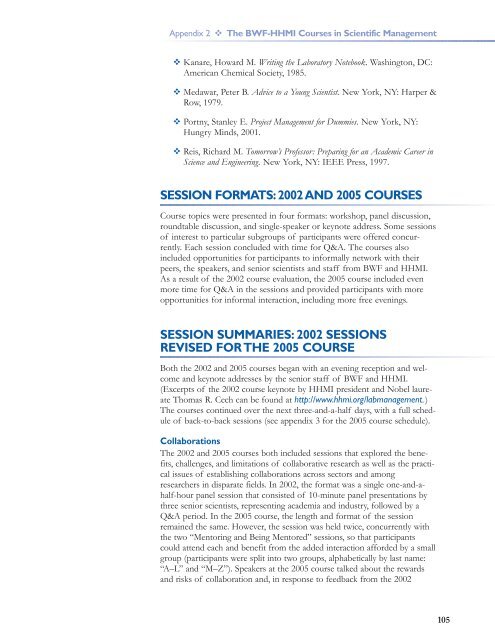Training Scientists to Make the Right Moves - Howard Hughes ...
Training Scientists to Make the Right Moves - Howard Hughes ...
Training Scientists to Make the Right Moves - Howard Hughes ...
Create successful ePaper yourself
Turn your PDF publications into a flip-book with our unique Google optimized e-Paper software.
Appendix 2 The BWF-HHMI Courses in Scientific Management<br />
Kanare, <strong>Howard</strong> M. Writing <strong>the</strong> Labora<strong>to</strong>ry Notebook. Washing<strong>to</strong>n, DC:<br />
American Chemical Society, 1985.<br />
Medawar, Peter B. Advice <strong>to</strong> a Young Scientist. New York, NY: Harper &<br />
Row, 1979.<br />
Portny, Stanley E. Project Management for Dummies. New York, NY:<br />
Hungry Minds, 2001.<br />
Reis, Richard M. Tomorrow’s Professor: Preparing for an Academic Career in<br />
Science and Engineering. New York, NY: IEEE Press, 1997.<br />
SESSION FORMATS: 2002 AND 2005 COURSES<br />
Course <strong>to</strong>pics were presented in four formats: workshop, panel discussion,<br />
roundtable discussion, and single-speaker or keynote address. Some sessions<br />
of interest <strong>to</strong> particular subgroups of participants were offered concurrently.<br />
Each session concluded with time for Q&A. The courses also<br />
included opportunities for participants <strong>to</strong> informally network with <strong>the</strong>ir<br />
peers, <strong>the</strong> speakers, and senior scientists and staff from BWF and HHMI.<br />
As a result of <strong>the</strong> 2002 course evaluation, <strong>the</strong> 2005 course included even<br />
more time for Q&A in <strong>the</strong> sessions and provided participants with more<br />
opportunities for informal interaction, including more free evenings.<br />
SESSION SUMMARIES: 2002 SESSIONS<br />
REVISED FOR THE 2005 COURSE<br />
Both <strong>the</strong> 2002 and 2005 courses began with an evening reception and welcome<br />
and keynote addresses by <strong>the</strong> senior staff of BWF and HHMI.<br />
(Excerpts of <strong>the</strong> 2002 course keynote by HHMI president and Nobel laureate<br />
Thomas R. Cech can be found at http://www.hhmi.org/labmanagement.)<br />
The courses continued over <strong>the</strong> next three-and-a-half days, with a full schedule<br />
of back-<strong>to</strong>-back sessions (see appendix 3 for <strong>the</strong> 2005 course schedule).<br />
Collaborations<br />
The 2002 and 2005 courses both included sessions that explored <strong>the</strong> benefits,<br />
challenges, and limitations of collaborative research as well as <strong>the</strong> practical<br />
issues of establishing collaborations across sec<strong>to</strong>rs and among<br />
researchers in disparate fields. In 2002, <strong>the</strong> format was a single one-and-ahalf-hour<br />
panel session that consisted of 10-minute panel presentations by<br />
three senior scientists, representing academia and industry, followed by a<br />
Q&A period. In <strong>the</strong> 2005 course, <strong>the</strong> length and format of <strong>the</strong> session<br />
remained <strong>the</strong> same. However, <strong>the</strong> session was held twice, concurrently with<br />
<strong>the</strong> two “Men<strong>to</strong>ring and Being Men<strong>to</strong>red” sessions, so that participants<br />
could attend each and benefit from <strong>the</strong> added interaction afforded by a small<br />
group (participants were split in<strong>to</strong> two groups, alphabetically by last name:<br />
“A–L” and “M–Z”). Speakers at <strong>the</strong> 2005 course talked about <strong>the</strong> rewards<br />
and risks of collaboration and, in response <strong>to</strong> feedback from <strong>the</strong> 2002<br />
105
















